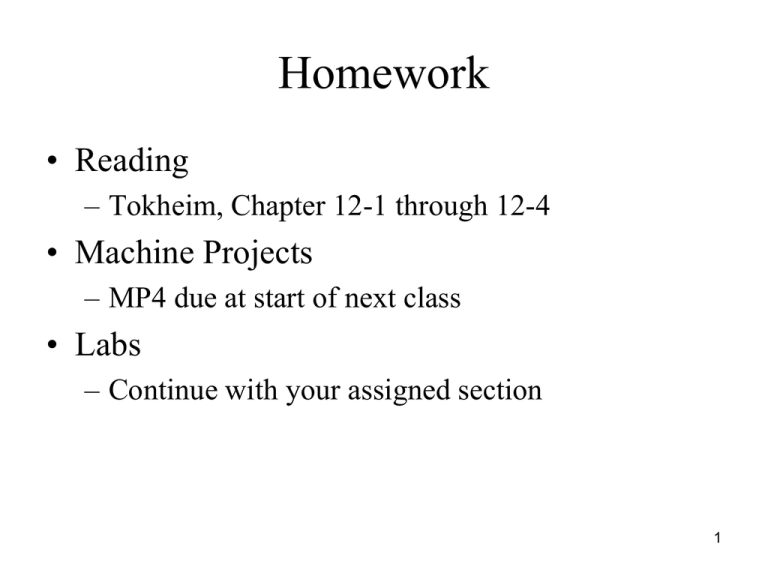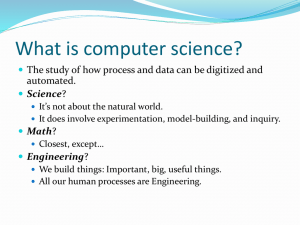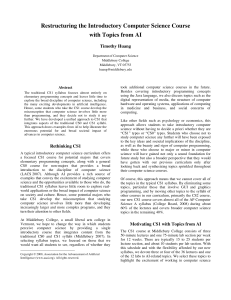Homework • Reading • Machine Projects • Labs
advertisement

Homework • Reading – Tokheim, Chapter 12-1 through 12-4 • Machine Projects – MP4 due at start of next class • Labs – Continue with your assigned section 1 Read Only Memory (ROM) • PC uses it to hold BIOS for system and I/O drivers • Slow (100-200 nanoseconds) • Various forms: – Read Only Memory (ROM) – Programmable Read Only Memory (PROM) – Erasable Programmable Read Only Memory (EPROM) – Electrically Erasable Programmable ROM (EEPROM) – Flash memory 2 Read Only Memory (ROM) • Diode Matrix Design Chip Enable O0 O1 A2 A1 Three bit Decoder O2 O3 O4 O5 A0 O6 O7 D0 +5V D1 Gnd D2 Presence of a diode means a 1, absence of a diode = 0 3 Programmable ROM • Diode Matrix Design Chip Enable O0 O1 A2 A1 Three bit Decoder O2 O3 O4 O5 A0 O6 O7 D0 +5V D1 Gnd Starts with all diodes/all ones. Burn out diodes where value needs to be zero. D2 4 Random Access Memory (RAM) • Static RAM = an array of full flip-flops • Simple interface and fast (10-20 nsec) but more costly (2 - 4X) than ROM A0 - A14 CS# W/R# OE# RAM Chip D0 - D7 • Small capacity compared to Dynamic RAMs 5 Dynamic RAM (DRAM) • Square array of simple one transistor memory cells • Capacitance at input to transistor remembers a 0 or 1 Column Bit Line Row Word Line • Reading contents of the cell is destructive • Over time, the charge leaks away (in milliseconds) 6 Dynamic RAM (DRAM) • For both reasons, HW must perform a memory refresh • Regularly reading/writing on a row and column basis • Advantages are: – Cells are simple – Uses less power • Disadvantage: – Slower (20 - 30 nsec access time) – Total cycle time is 2X due to refresh after read • Bottom line – 2-4X less chip area and 2-4X less power – Interleaving and access in column or page mode 7 Example Layouts of Memory Parts • Organized 1 Meg x 1 or Organized 128K x 8 Address Bits Address Bits 20 *** (1 Meg Bits) One Data Bit Per Chip Need 32 Chips For a 32 bit bus 17 (1 Meg Bits) Eight Data Bits Per Chip Need 4 Chips For 32 bit bus Number of Data Bit Pins Attached to Data Bus 8 Full Address Decoding • Each location within a memory component responds to only one unique address • Need to use all the address lines in decoding • May choose not to fill-in some portions of the address space with real memory (empty spots) 9 Addressing Memory Components A23 Combinational Logic ... A12 A11 CS1# CS0# ... CPU D0-D7 W/R# A01 A00 M0 4K x 8 D0-D7 W/R# CS0# M1 4K x 8 D0-D7 CS1# W/R# 10 Memory Map and Comb. Logic A23 A22 A21 A20 A19 A18 A17 A16 A15 A14 A13 A12 A11 A10 A09 A08 00 0000 CS0 CS1 Empty Space (Bus Error If Accessed) 00 0FFF 00 1000 00 1FFF 00 2000 * * * CS0 0 0 0 0 0 0 0 0 0 0 0 0 X X X X CS1 0 0 0 0 0 0 0 0 0 0 0 1 X X X X A23 A22 . . . . . . CS1# A13 CS0# A12 FF FFFF 11 Partial Address Decoding • Simpler and less expensive • Some address lines are NOT used in the address decoding process to generate chip enable signals • Many groups of addresses can map to the same physical memory chip 12 Partial Address Decoding A23 . A12 A11 . CPU D0-D7 R/W* A01 A00 M0 4K x 8 D0-D7 R/W# CS0# M1 4K x 8 D0-D7 CS1# R/W# 13 Memory Map for Partial Decoding 00 0000 CS0 CS0 00 0FFF 00 1000 00 1FFF *** CS0 CS1 CS0 is repeated 2,048 times in the memory space 00 0000 to 7F FFFF 7F FFFF 80 0000 CS1 CS1 is repeated 2,048 times in the memory space 80 0000 to FF FFFF *** CS1 FF FFFF 14 Comb. Logic for CS0 and CS1 A23 A22 A21 A20 A19 A18 A17 A16 A15 A14 A13 A12 A11 A10 A09 A08 00 0000 CS0 CS0 00 0FFF 00 1000 00 1FFF CS0 0 X X X X X X X X X X X X X X X CS1 1 X X X X X X X X X X X X X X X *** CS0 CS1 CS1# 7F FFFF 80 0000 CS1 A23 CS0# *** CS1 FF FFFF 15 Mixed Address Decoding • A mixture or a compromise between partial and full address decoding • Divide the memory space into a number of fully decoded blocks, generally of equal size • Use high-order address bits to select the block and low-order address bits to select a sub-block 16 Comb. Logic for CS0, CS1, CS2, & CS3 A23 A22 A21 A20 A19 A18 A17 A16 A15 A14 A13 A12 A11 A10 A09 A08 CS0 0 0 0 0 0 0 0 0 0 0 0 0 X X X X CS1 0 1 0 0 0 0 0 0 0 0 0 0 X X X X A23 A22 A21 A20 A19 A18 A17 A16 A15 A14 A13 A12 A11 A10 A09 A08 CS2 1 X X X X X X X X X X 0 X X X X CS3 1 X X X X X X X X X X 1 X X X X Logic Diagram for CS0# and CS1# Similar to Diagram on Slide 11 Except A22 and A12 are swapped A23 A12 CS2# CS3# 17 Memory Map for Mixed Decoding CS0 00 0000 00 0FFF Empty 00 1000 3F FFFF CS1 40 0000 40 0FFF Empty 40 1000 7F FFFF 80 0000 CS0/CS1 each decoded only once in the memory space 00 0000 to 7F FFFF CS2 CS3 CS2/CS3 are repeated 1,024 times in the memory space 80 0000 to FF FFFF *** CS3 FF FFFF 18






